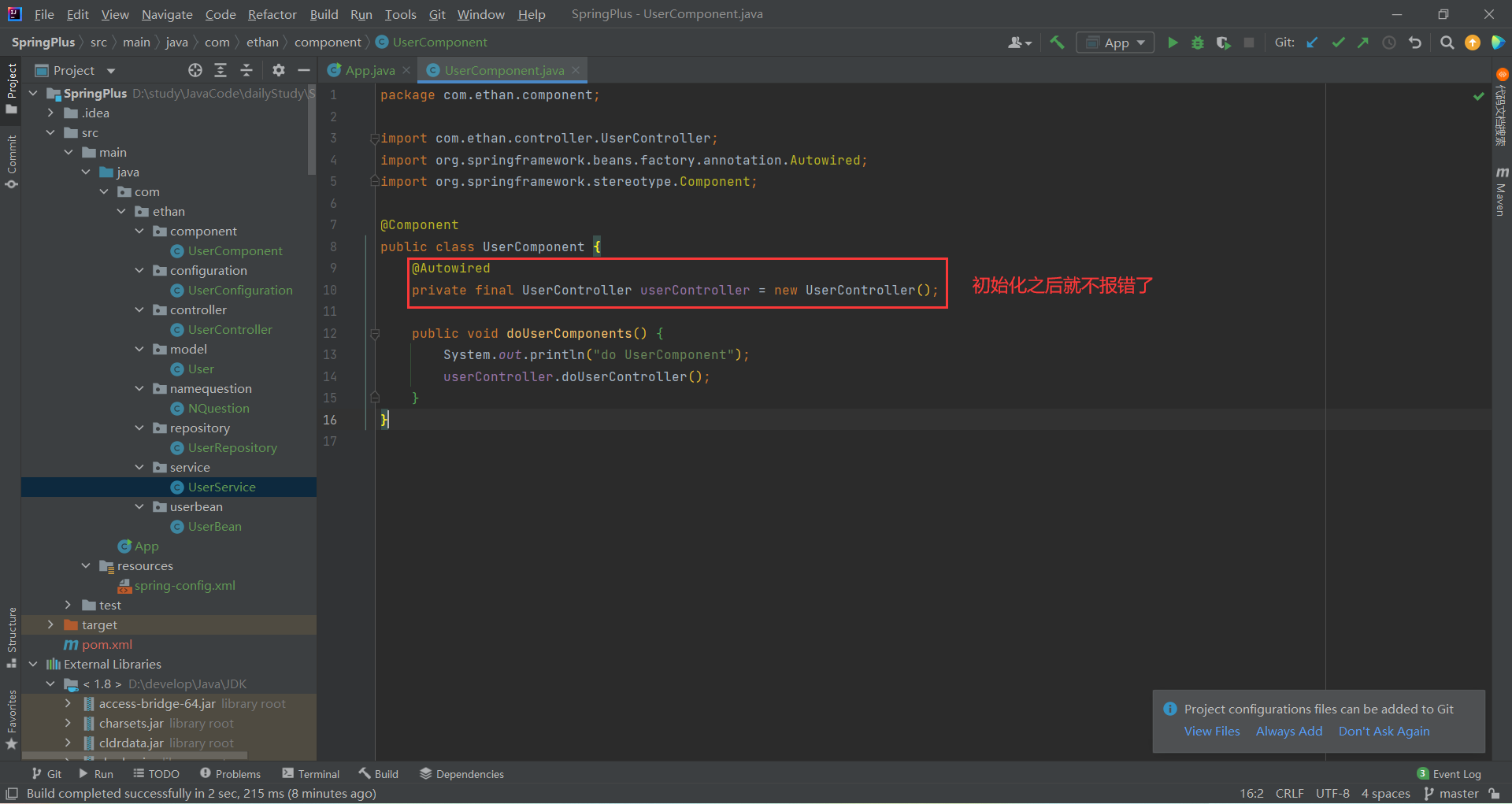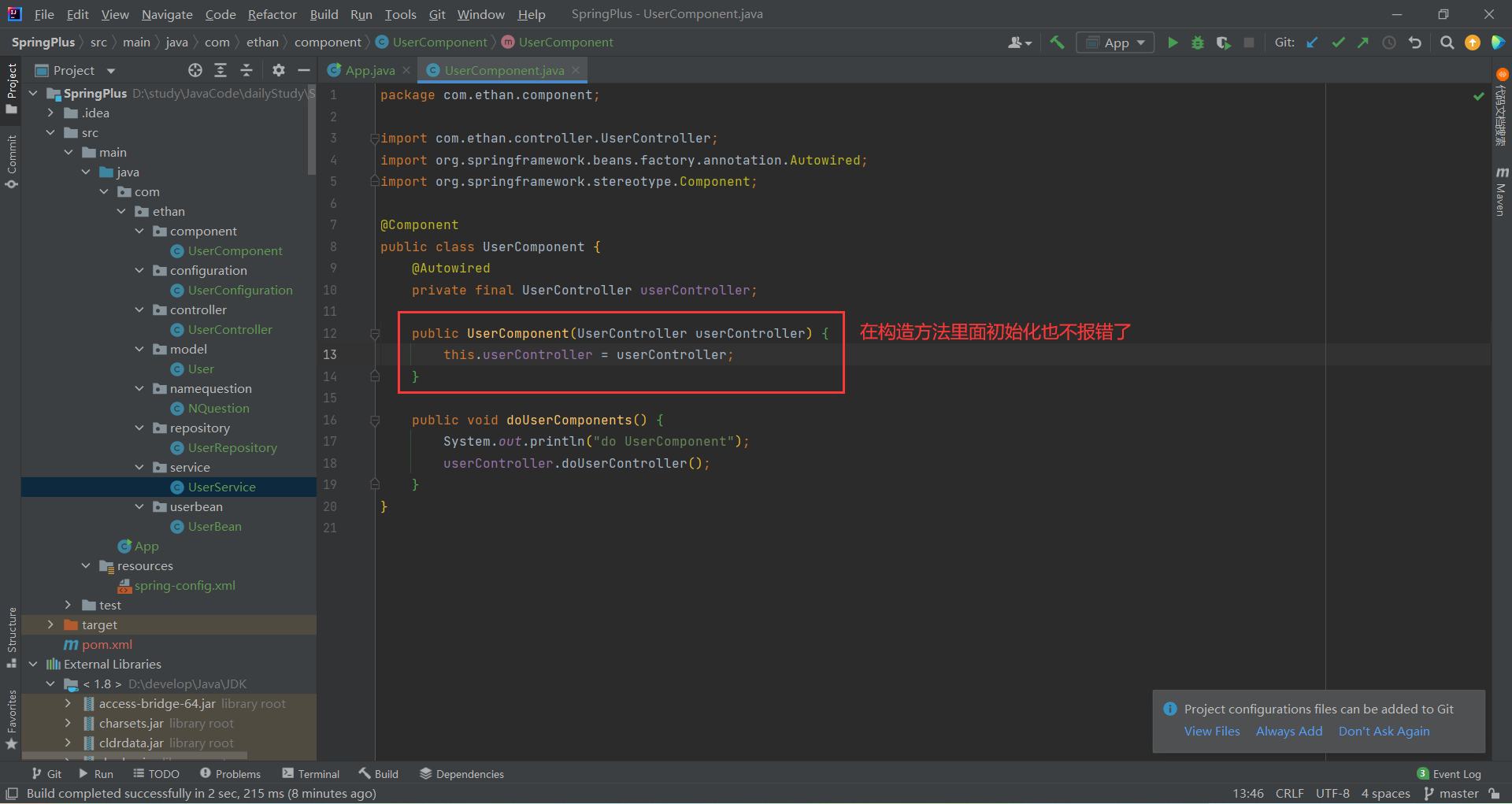Spring 更简单的读取和存储对象 – 2
- 三 . 获取 Bean 对象
- 3.1 属性注入
- 3.1.1 原理
- 3.1.2 相关问题
- 能在启动类里面调用 [@Autowired ](/Autowired ) 注解吗
- [@Autowired ](/Autowired ) 能使用多次吗
- @Autowired 修饰的私有方法名字可以是其他的吗
- 3.1.3 属性注入的优点和缺点
- 3.2 Setter 注入
- 3.2.1 用法
- 3.2.2 优点以及缺点
- 3.3 构造方法注入
- 3.3.1 用法
- 3.3.2 注意事项
- 3.3.3 构造方法注入的优点
- 3.4 同一类型多个Bean报错 -> @Resources
- 3.4.1 用法
- 3.4.2 @Resources 不能在构造方法上使用
- 3.4.3 [@Resources ](/Resources ) 参数 VS [@Autowired ](/Autowired ) 参数
- 3.5 综合练习
- 四 . 总结
大家新年快乐 , 祝大家新的一年如图
这个专栏给大家介绍一下 Java 家族的核心产品 – SSM 框架
JavaEE 进阶专栏Java 语言能走到现在 , 仍然屹立不衰的原因 , 有一部分就是因为 SSM 框架的存在
接下来 , 博主会带大家了解一下 Spring、Spring Boot、Spring MVC、MyBatis 相关知识点
并且带领大家进行环境的配置 , 让大家真正用好框架、学懂框架
来上一篇文章复习一下吧
点击即可跳转到我的小秘密
本篇文章是基于在上一篇文章的进一步讲解 , 所以需要读者有上一篇文章的基础
三 . 获取 Bean 对象
我们最早的方式是这样的
package com.ethan.Controller;import com.ethan.service.UserService;import org.springframework.stereotype.Controller;@Controllerpublic class UserController {// 读取 UserServicepublic void sayHello() {UserService userService = new UserService();userService.doService();}}直接通过 new 的方式我们是不推荐的
然后接下来进入了 2.0 时代
我们设置一个启动类 , 在里面首先要得到得到上下文对象 , 然后去使用 getBean 得到 Bean 对象 , 最后再去操作 Bean 对象 , 这种方法还是不太简便![图片[3] - JavaEE 突击 5 – Spring 更简单的读取和存储对象(2) - MaxSSL](https://www.maxssl.com/uploads/?url=https://img-blog.csdnimg.cn/img_convert/c5d83f7667030769977f3499b61023ac.png)
所以迎来了我们的 3.0 时代 : 依赖注入
获取 bean 对象也叫做 对象装配 ,是把对象取出来放到某个类中,有时候也叫对象注入, 也叫做依赖注入(DI)
在程序运行期间 , 将当前类需要的对象动态的引入到当前的类当中 , 这个过程就叫做依赖注入
对象装配(对象注⼊)的实现⽅法以下 3 种:
- 属性注入
- Setter 注入
- 构造方法注入
我们先来看一下他们的使用
3.1 属性注入
3.1.1 原理
我们就在 UserController 里面调用 UserService , 也就是将 UserService 注入到 UserController 里面 , 咱们再去调用 UserController
我们先创建一个私有的属性 , 这个属性就是我们要注入的对象
然后在这个私有属性上面加上 @Autowired注解 (因为我们想要把 userService 注入到 UserController 里面) , 他的意思是自动装配![图片[4] - JavaEE 突击 5 – Spring 更简单的读取和存储对象(2) - MaxSSL](https://www.maxssl.com/uploads/?url=https://img-blog.csdnimg.cn/img_convert/5ecaad67ad1025ac0c1e37e9bc0ffb6f.png)
为什么叫属性注入呢 ” />@Autowired注解去掉 , 其实就剩个私有的属性 , 所以就叫属性注入
接下来我们就可以调用 userService 的方法了
package com.ethan.controller;import com.ethan.service.UserService;import org.springframework.beans.factory.annotation.Autowired;import org.springframework.stereotype.Controller;@Controllerpublic class UserController {@Autowiredprivate UserService userService;//想要注入的属性public void doUserController() {System.out.println("do UserController");userService.doUserService();}}我们可以去启动类看看效果了
import com.ethan.controller.UserController;import org.springframework.context.ApplicationContext;import org.springframework.context.support.ClassPathXmlApplicationContext;public class App {public static void main(String[] args) {// 1. 得到上下文对象ApplicationContext context =new ClassPathXmlApplicationContext("spring-config.xml");// 2. 使用 getBean 得到 Bean 对象UserController userController = context.getBean("userController",UserController.class);// 3. 操作对象userController.doUserController();}}运行查看结果![图片[5] - JavaEE 突击 5 – Spring 更简单的读取和存储对象(2) - MaxSSL](https://www.maxssl.com/uploads/?url=https://www.maxssl.com/uploads/?url=https://img-blog.csdnimg.cn/img_convert/ae98d4dde0a9dda3863eeb59e94ab790.png)
这就说明我们在 UserController 里面成功的把 UserService 注入成功
那么我们把 @Autowired去掉呢 ![图片[6] - JavaEE 突击 5 – Spring 更简单的读取和存储对象(2) - MaxSSL](https://www.maxssl.com/uploads/?url=https://img-blog.csdnimg.cn/img_convert/b8dfd0eaad07ebf89583cfb14c2ad57c.png)
3.1.2 相关问题
能在启动类里面调用 @Autowired注解吗
那么这里面有个问题 , 我们的启动类里面还是 2.0 版本的方法 , 那么我们为什么不直接在启动类里面去添加 @Autowired呢
import com.ethan.service.UserService;import org.springframework.beans.factory.annotation.Autowired;public class App {@Autowiredprivate UserService userService;public static void main(String[] args) {userService.doUserService();}}![图片[7] - JavaEE 突击 5 – Spring 更简单的读取和存储对象(2) - MaxSSL](https://www.maxssl.com/uploads/?url=https://img-blog.csdnimg.cn/img_convert/083847f94276e5a5e2750f71fd48a67a.png)
给大家分析一下原因
在 Java 里面 , 静态类或者静态方法优先执行![图片[8] - JavaEE 突击 5 – Spring 更简单的读取和存储对象(2) - MaxSSL](https://www.maxssl.com/uploads/?url=https://img-blog.csdnimg.cn/img_convert/9f8f30fef64c63c049f34d35f8c04fe7.png)
@Autowired能使用多次吗
我们目前是在 UserController 里面注入了 UserService , 那么我们在 UserComponent 里面注入 UserController
UserComponent.java
package com.ethan.component;import com.ethan.controller.UserController;import org.springframework.beans.factory.annotation.Autowired;import org.springframework.stereotype.Component;@Componentpublic class UserComponent {@Autowiredprivate UserController userController;public void doUserComponents() {System.out.println("do UserComponent");userController.doUserController();}}UserController.java
package com.ethan.controller;import com.ethan.service.UserService;import org.springframework.beans.factory.annotation.Autowired;import org.springframework.stereotype.Controller;@Controllerpublic class UserController {@Autowiredprivate UserService userService;//想要注入的属性public void doUserController() {System.out.println("do UserController");userService.doUserService();}}UserService.java
package com.ethan.service;import org.springframework.stereotype.Service;@Servicepublic class UserService {public void doUserService() {System.out.println("do UserService");}}启动类 :
import com.ethan.component.UserComponent;import org.springframework.context.ApplicationContext;import org.springframework.context.support.ClassPathXmlApplicationContext;public class App {public static void main(String[] args) {// 1. 得到上下文对象ApplicationContext context =new ClassPathXmlApplicationContext("spring-config.xml");// 2. 使用 getBean 得到 Bean 对象UserComponent userComponent = context.getBean("userComponent",UserComponent.class);// 3. 操作对象userComponent.doUserComponents();}}![图片[9] - JavaEE 突击 5 – Spring 更简单的读取和存储对象(2) - MaxSSL](https://www.maxssl.com/uploads/?url=https://img-blog.csdnimg.cn/img_convert/d906d1b929fdaf04206aa6684133e4d2.png)
打印了三句话 , 这就代表 @Autowired 可以多次使用
@Autowired 修饰的私有方法名字可以是其他的吗
![图片[10] - JavaEE 突击 5 – Spring 更简单的读取和存储对象(2) - MaxSSL](https://www.maxssl.com/uploads/?url=https://img-blog.csdnimg.cn/img_convert/3083a05a19e0c38d6fae9db629cf9688.png)
那么我们改一下属性名试试看![图片[11] - JavaEE 突击 5 – Spring 更简单的读取和存储对象(2) - MaxSSL](https://www.maxssl.com/uploads/?url=https://img-blog.csdnimg.cn/img_convert/c49e2b8aeb846fc2664d84c4d9bfaa72.png)
那么为什么我们之前的名称就有要求 , 这个就没有呢
这个其实也是我们的一道面试题 : @Autowired和 @Resource有什么区别
这篇博客写的非常细致
@Autowired 和 @Resource 有什么区别
我们看这张图![图片[12] - JavaEE 突击 5 – Spring 更简单的读取和存储对象(2) - MaxSSL](https://www.maxssl.com/uploads/?url=https://img-blog.csdnimg.cn/img_convert/c27fe848cb687997bdd737e6cd7afedb.png)
我们的 @Autowired是先通过类型去查找 , 比如我们这个例子 ![图片[13] - JavaEE 突击 5 – Spring 更简单的读取和存储对象(2) - MaxSSL](https://www.maxssl.com/uploads/?url=https://img-blog.csdnimg.cn/img_convert/933024b499eb23e27bcdf6d7f6b39a28.png)
所以我们的 @Autowired注解 是先根据类型查询 , 之后根据名称查询
3.1.3 属性注入的优点和缺点
优点 : 写法简单
缺点 :
- 最重要的缺点就是 IDEA 不推荐我们使用 ! 我们在 社区版里面看不见 , 去专业版里面给大家看一下 , 学生可以去学生认证使用专业版
![图片[14] - JavaEE 突击 5 – Spring 更简单的读取和存储对象(2) - MaxSSL](data:image/svg+xml,%3Csvg%20xmlns=%22http://www.w3.org/2000/svg%22%20viewBox=%220%200%20210%20140%22%3E%3C/svg%3E)
但是比较有意思的是 : Spring 官方放出来的 代码样例 , 自己也这么用 , 因为他真的简单易用 - 功能缺陷 : 不能注入一个 final 修饰的属性
![图片[15] - JavaEE 突击 5 – Spring 更简单的读取和存储对象(2) - MaxSSL](data:image/svg+xml,%3Csvg%20xmlns=%22http://www.w3.org/2000/svg%22%20viewBox=%220%200%20210%20140%22%3E%3C/svg%3E)
这是因为 Java 语法规定 , final 修饰的变量必须要有初始值
可以这样解决
1.final 修饰的变量我们可以初始化
2.在构造方法里面赋值
- 通用性问题 : 属性注入这种方式只适用于 IoC 容器(框架) -> 可移植性不高
- 设计原则问题 : 因为这种方式写法比较简单 , 所以就有可能造成滥用 , 更容易违背单一设计原则
单一设计原则 : 这个类设计出来只干一件事
3.2 Setter 注入
3.2.1 用法
还是先写一个私有的属性
然后去生成他的 set 方法![图片[16] - JavaEE 突击 5 – Spring 更简单的读取和存储对象(2) - MaxSSL](https://www.maxssl.com/uploads/?url=https://img-blog.csdnimg.cn/img_convert/dd93368e744d5e90e82b07f5cd1fa336.png)
![图片[17] - JavaEE 突击 5 – Spring 更简单的读取和存储对象(2) - MaxSSL](https://www.maxssl.com/uploads/?url=https://img-blog.csdnimg.cn/img_convert/a85be3bb506816d891aeaa9126c3037d.png)
![图片[18] - JavaEE 突击 5 – Spring 更简单的读取和存储对象(2) - MaxSSL](https://www.maxssl.com/uploads/?url=https://img-blog.csdnimg.cn/img_convert/d22912fedeb00a887bc80a61d3b3c9d9.png)
这样我们的 setter 方法就构造好了![图片[19] - JavaEE 突击 5 – Spring 更简单的读取和存储对象(2) - MaxSSL](https://www.maxssl.com/uploads/?url=https://img-blog.csdnimg.cn/img_convert/5d446540bc50773edc1c722bbbea6110.png)
接下来 , 我们只需要在 setter 方法上面加上 @Autowired 注解就好了![图片[20] - JavaEE 突击 5 – Spring 更简单的读取和存储对象(2) - MaxSSL](https://www.maxssl.com/uploads/?url=https://img-blog.csdnimg.cn/img_convert/918edcc5b5923e69f09133430ce8c06a.png)
package com.ethan.component;import com.ethan.controller.UserController;import org.springframework.beans.factory.annotation.Autowired;import org.springframework.stereotype.Component;@Componentpublic class UserComponent {private UserController userController;@Autowiredpublic void setUserController(UserController userController) {this.userController = userController;}public void doUserComponents() {System.out.println("do UserComponent");userController.doUserController();}}我们试一下可不可以
去启动类编写代码
import com.ethan.component.UserComponent;import org.springframework.context.ApplicationContext;import org.springframework.context.support.ClassPathXmlApplicationContext;public class App {public static void main(String[] args) {// 1. 得到上下文对象ApplicationContext context =new ClassPathXmlApplicationContext("spring-config.xml");// 2. 使用 getBean 得到 Bean 对象UserComponent userComponent = context.getBean("userComponent",UserComponent.class);// 3. 操作对象userComponent.doUserComponents();}}运行一下![图片[21] - JavaEE 突击 5 – Spring 更简单的读取和存储对象(2) - MaxSSL](https://www.maxssl.com/uploads/?url=https://img-blog.csdnimg.cn/img_convert/d6c24ff4525f5af4c575261105154a70.png)
3.2.2 优点以及缺点
优点 : 符合单一设计原则 , 一个 set 就是针对一个对象的
缺点 :
- 不能注入不可变对象
![图片[22] - JavaEE 突击 5 – Spring 更简单的读取和存储对象(2) - MaxSSL](data:image/svg+xml,%3Csvg%20xmlns=%22http://www.w3.org/2000/svg%22%20viewBox=%220%200%20210%20140%22%3E%3C/svg%3E)
- 注入对象可能会被改变
因为这个 set 方法可以会被调用多次 , 就有可能造成被修改的风险
3.3 构造方法注入
3.3.1 用法
还是先写一个要注入的私有属性 , 然后生成这个类的构造方法![图片[23] - JavaEE 突击 5 – Spring 更简单的读取和存储对象(2) - MaxSSL](https://www.maxssl.com/uploads/?url=https://img-blog.csdnimg.cn/img_convert/55b4359e90c46ba830a170ee943f98be.png)
![图片[24] - JavaEE 突击 5 – Spring 更简单的读取和存储对象(2) - MaxSSL](https://www.maxssl.com/uploads/?url=https://img-blog.csdnimg.cn/img_convert/6b55866c018d6b398850e4a358150100.png)
![图片[25] - JavaEE 突击 5 – Spring 更简单的读取和存储对象(2) - MaxSSL](https://www.maxssl.com/uploads/?url=https://img-blog.csdnimg.cn/img_convert/cbc2af6430690bfd301ed2176751f2c3.png)
这样构造方法就自动生成好了 , 构造方法里面的参数就是要注入的属性![图片[26] - JavaEE 突击 5 – Spring 更简单的读取和存储对象(2) - MaxSSL](https://www.maxssl.com/uploads/?url=https://img-blog.csdnimg.cn/img_convert/0ca77da6439b0024e936c672a7471558.png)
最后在构造方法上面添加 @Autowired注解
UserComponent.java :
package com.ethan.component;import com.ethan.controller.UserController;import org.springframework.beans.factory.annotation.Autowired;import org.springframework.stereotype.Component;@Componentpublic class UserComponent {private UserController userController;@Autowiredpublic UserComponent(UserController userController) {this.userController = userController;}public void doUserComponents() {System.out.println("do UserComponent");userController.doUserController();}}启动类
import com.ethan.component.UserComponent;import org.springframework.context.ApplicationContext;import org.springframework.context.support.ClassPathXmlApplicationContext;public class App {public static void main(String[] args) {// 1. 得到上下文对象ApplicationContext context =new ClassPathXmlApplicationContext("spring-config.xml");// 2. 使用 getBean 得到 Bean 对象UserComponent userComponent = context.getBean("userComponent",UserComponent.class);// 3. 操作对象userComponent.doUserComponents();}}运行一下 :![图片[27] - JavaEE 突击 5 – Spring 更简单的读取和存储对象(2) - MaxSSL](https://www.maxssl.com/uploads/?url=https://img-blog.csdnimg.cn/img_convert/798ec0b970011fcd77f268fa59f794d7.png)
根据运行结果 , 我们还可以看出 : 构造方法也支持注入多个对象
3.3.2 注意事项
当前类只有一个构造方法的时候 , @Autowired 可以省略 ![图片[28] - JavaEE 突击 5 – Spring 更简单的读取和存储对象(2) - MaxSSL](https://www.maxssl.com/uploads/?url=https://img-blog.csdnimg.cn/img_convert/03bee89c01ef81f218fb3858267aaedc.png)
有多个构造方法的时候 , @Autowired 不可以省略 ![图片[29] - JavaEE 突击 5 – Spring 更简单的读取和存储对象(2) - MaxSSL](https://www.maxssl.com/uploads/?url=https://img-blog.csdnimg.cn/img_convert/66701163e3e7bd4f1ec981bed399c765.png)
![图片[30] - JavaEE 突击 5 – Spring 更简单的读取和存储对象(2) - MaxSSL](https://www.maxssl.com/uploads/?url=https://img-blog.csdnimg.cn/img_convert/12364153fd9f505d631aa3c52dcac2fd.png)
而且要关注的是 : 多个构造方法的时候 , 只会运行加了 @Autowired的构造方法 ![图片[31] - JavaEE 突击 5 – Spring 更简单的读取和存储对象(2) - MaxSSL](https://www.maxssl.com/uploads/?url=https://img-blog.csdnimg.cn/img_convert/c5da0e3dd67e42793740a40f44f33695.png)
![图片[32] - JavaEE 突击 5 – Spring 更简单的读取和存储对象(2) - MaxSSL](https://www.maxssl.com/uploads/?url=https://img-blog.csdnimg.cn/img_convert/40c2565ee5283b885e42e9248691879b.png)
那么我们都加上 @Autowired呢 ” />
总结一下 : 在 Spring 中 , 一个类的构造方法可以有多个 , 但是只能有一个构造方法上添加 @Autowired注解 , 否则会报错
3.3.3 构造方法注入的优点
优点1 : 可以注入 final 修饰的对象
原因 : 遵循了 Java 的规范
final 的用法 :
- 创建时直接赋值
- 在构造方法中赋值
这样就不难理解了 , 在 Java 里面就允许通过构造方法给被 final 修饰的值进行赋值 , 那么我们的 Spring 里面也可以通过构造注入对 final 修饰的值进行赋值
那么我们就来实验一下 :
package com.ethan.component;import com.ethan.controller.UserController;import org.springframework.beans.factory.annotation.Autowired;import org.springframework.stereotype.Component;@Componentpublic class UserComponent {private final UserController userController;@Autowiredpublic UserComponent(UserController userController) {this.userController = userController;}public void doUserComponents() {System.out.println("do UserComponent");userController.doUserController();}}![图片[36] - JavaEE 突击 5 – Spring 更简单的读取和存储对象(2) - MaxSSL](https://www.maxssl.com/uploads/?url=https://img-blog.csdnimg.cn/img_convert/f5336b640c30505b790b9bf94c796882.png)
优点2 : 注入对象不能被修改 (构造方法只会被执行一次)
优点3 : 要注入的对象在使用前一定会被完全初始化 , 因为注入依赖是在类的构造方法中执行的 , 而构造方法是在类创建之初就会执行的方法
优点4 : 通用性更好 , 因为构造方法是 Java (JDK) 所支持的 , 而 JDK 我们可以认为是 Spring 最低层的框架 , 所以更换任何的框架 , 它都是适用的
缺点 : (优点那么多 , 缺点就变得不是那么重要了)
构造方法不满足单一设计原则![图片[37] - JavaEE 突击 5 – Spring 更简单的读取和存储对象(2) - MaxSSL](https://www.maxssl.com/uploads/?url=https://img-blog.csdnimg.cn/img_convert/09d65677fedbf08c7a8b09baf71d759c.png)
Spring 4.2 推荐的注入用法是 Setter 注入 , Setter 更加符合单一设计原则
在 Spring 4.2 之后 , 推荐使用构造方法注入的方式 . 官方给出的回复是 如果你写的代码传递了太多的参数 , 那么此时你要考虑一下你的代码是否符合单一设计原则了
其实就是官方赖你了 , 你自己代码写的不好 , 还赖上我了 .
3.4 同一类型多个Bean报错 -> @Resources
3.4.1 用法
这是另外一个注入关键字 , 是由 Java 官方提供给我们的注解
用法是跟我们 @Autowired 大致是一样的
我们新创建一个 resources 包 , 新建一个 ReSourcesTest 来试验一下 @Resources
然后在 ReSourcesTest.java 编写代码
package com.ethan.reSources;import com.ethan.component.UserComponent;import org.springframework.stereotype.Controller;import javax.annotation.Resource;@Controllerpublic class ReSourcesTest {@Resourceprivate UserComponent userComponent;public void doResource() {System.out.println("do Resource");userComponent.doUserComponents();}}我们 Ctrl + 单击 一下 @Resources![图片[38] - JavaEE 突击 5 – Spring 更简单的读取和存储对象(2) - MaxSSL](https://www.maxssl.com/uploads/?url=https://img-blog.csdnimg.cn/img_convert/c7a329a543b0f36aa670ecf257672b45.png)
发现 @Resources是来自于 Java 提供给我们的方法
那么我们就来试试 Java 给我们提供的办法好不好使
启动类 :
import com.ethan.component.UserComponent;import com.ethan.reSources.ReSourcesTest;import org.springframework.context.ApplicationContext;import org.springframework.context.support.ClassPathXmlApplicationContext;public class App {public static void main(String[] args) {// 1. 得到上下文对象ApplicationContext context =new ClassPathXmlApplicationContext("spring-config.xml");// 2. 使用 getBean 得到 Bean 对象ReSourcesTest reSourcesTest = context.getBean("reSourcesTest",ReSourcesTest.class);// 3. 操作对象reSourcesTest.doResource();}}![图片[39] - JavaEE 突击 5 – Spring 更简单的读取和存储对象(2) - MaxSSL](https://www.maxssl.com/uploads/?url=https://img-blog.csdnimg.cn/img_convert/27d43b4b8d47b0865da985f9d32cde70.png)
那么属性注入可以 , Setter 注入 以及 构造方法注入呢 ” />package com.ethan.reSources;import com.ethan.component.UserComponent;import org.springframework.stereotype.Controller;import javax.annotation.Resource;@Controllerpublic class ReSourcesTest {private UserComponent userComponent;@Resourcepublic void setUserComponent(UserComponent userComponent) {this.userComponent = userComponent;}public void doResource() {System.out.println(“do Resource”);userComponent.doUserComponents();}}
![图片[40] - JavaEE 突击 5 – Spring 更简单的读取和存储对象(2) - MaxSSL](https://www.maxssl.com/uploads/?url=https://www.maxssl.com/uploads/?url=https://img-blog.csdnimg.cn/img_convert/d2e13f51e7a134fbf6254126a0c86915.png)
但是构造方法注入不可以 !
package com.ethan.reSources;import com.ethan.component.UserComponent;import org.springframework.stereotype.Controller;import javax.annotation.Resource;@Controllerpublic class ReSourcesTest {private UserComponent userComponent;@Resourcepublic ReSourcesTest(UserComponent userComponent) {this.userComponent = userComponent;}public void doResource() {System.out.println("do Resource");userComponent.doUserComponents();}}![图片[41] - JavaEE 突击 5 – Spring 更简单的读取和存储对象(2) - MaxSSL](https://www.maxssl.com/uploads/?url=https://img-blog.csdnimg.cn/img_convert/c64fd13c510e092d94096adfe9412e8c.png)
强行执行仍然会报错的![图片[42] - JavaEE 突击 5 – Spring 更简单的读取和存储对象(2) - MaxSSL](https://www.maxssl.com/uploads/?url=https://img-blog.csdnimg.cn/img_convert/342fa16f3fb122cabed2a77fe81939e1.png)
3.4.2 @Resources 不能在构造方法上使用
那么既然 @Autowired 能用 , 我们为什么还要介绍 @Resources 呢 ” />
![图片[43] - JavaEE 突击 5 – Spring 更简单的读取和存储对象(2) - MaxSSL](https://www.maxssl.com/uploads/?url=https://www.maxssl.com/uploads/?url=https://img-blog.csdnimg.cn/img_convert/ba412cef5f1a96aa638ac231b26fe9bb.png)
![图片[44] - JavaEE 突击 5 – Spring 更简单的读取和存储对象(2) - MaxSSL](https://www.maxssl.com/uploads/?url=https://img-blog.csdnimg.cn/img_convert/31b1a7ad74c61970b56c04d7434155fe.png)
原因是 : Java 实现的时候 , 构造方法是先执行的 , 但是这个注解是在构造方法之后执行的 , 所以目前是不支持这种实现的
3.4.3 @Resources参数 VS @Autowired参数
我们直接看源码
先看 @Resources
Ctrl + 单击 @Resources![图片[45] - JavaEE 突击 5 – Spring 更简单的读取和存储对象(2) - MaxSSL](https://www.maxssl.com/uploads/?url=https://img-blog.csdnimg.cn/img_convert/6f4d4876d6565486ae53b2391648d2f0.png)
再看 @Autowired![图片[46] - JavaEE 突击 5 – Spring 更简单的读取和存储对象(2) - MaxSSL](https://www.maxssl.com/uploads/?url=https://img-blog.csdnimg.cn/img_convert/19a3b45806e83b7341d32b8dfa25a63f.png)
他们两个支持的参数完全不同 , 就这么一看 , 还是感觉 @Resources能用的方法多
给大家举个栗子 :
当使用 Bean 注解返回两个类型相同的 Bean 的时候 , 默认使用注入的方式得到对象就会报错 , 这么说大家有点乱 , 用代码来看一下
在之前的 UserBeans 里面有两个方法 , 他们的返回值相同 , 都是 User
UserBean.java :
package com.ethan.userbean;import com.ethan.model.User;import org.springframework.context.annotation.Bean;import org.springframework.stereotype.Controller;@Controllerpublic class UserBean {@Bean("anlingrong")public User func() {// 构建测试数据User user = new User();user.setName("安陵容");user.setAge(18);user.setId(1);return user;}@Bean("shenmeizhuang")public User func2() {User user = new User();user.setName("沈眉庄");user.setAge(20);user.setId(2);return user;}}![图片[47] - JavaEE 突击 5 – Spring 更简单的读取和存储对象(2) - MaxSSL](https://www.maxssl.com/uploads/?url=https://img-blog.csdnimg.cn/img_convert/7dde110e7bf1943f538942e919b92e71.png)
然后新建一个类 UserBean2 , 先试验一下 @Autowired![图片[48] - JavaEE 突击 5 – Spring 更简单的读取和存储对象(2) - MaxSSL](https://www.maxssl.com/uploads/?url=https://img-blog.csdnimg.cn/img_convert/55afcbbc89fb6f8d2086abf5ee90eeae.png)
package com.ethan.userbean;import com.ethan.model.User;import org.springframework.beans.factory.annotation.Autowired;import org.springframework.stereotype.Controller;@Controllerpublic class UserBean2 {@Autowiredprivate User user;public void method() {System.out.println(user.getName());}}然后设置启动类
import com.ethan.component.UserComponent;import com.ethan.reSources.ReSourcesTest;import com.ethan.userbean.UserBean2;import org.springframework.context.ApplicationContext;import org.springframework.context.support.ClassPathXmlApplicationContext;public class App {public static void main(String[] args) {// 1. 得到上下文对象ApplicationContext context =new ClassPathXmlApplicationContext("spring-config.xml");// 2. 使用 getBean 得到 Bean 对象UserBean2 userBean2 = context.getBean("userBean2",UserBean2.class);// 3. 操作对象userBean2.method();}}运行就报错了![图片[49] - JavaEE 突击 5 – Spring 更简单的读取和存储对象(2) - MaxSSL](https://www.maxssl.com/uploads/?url=https://img-blog.csdnimg.cn/img_convert/b9106dca8afcb44fb5587914f9704d16.png)
@Autowired是先按照类型去找 , 如果找到了 , 但是找到了不止一个的话 , 就需要按名字去查询 .
如果还没找到 , 那就报错 .
那么我们这个例子 , 类型找到了 , 这种类型对应了两个 Bean 对象 , 那么按名字找 , 没找到名字叫做 user 的方法名 , 就报错了.
我们也可以演示一下按名字能找到的场景![图片[50] - JavaEE 突击 5 – Spring 更简单的读取和存储对象(2) - MaxSSL](https://www.maxssl.com/uploads/?url=https://img-blog.csdnimg.cn/img_convert/054cc924d8282aace1132f60e7452b01.png)
那么其实我们可以使用 @Resources 来避免这种情况
@Resources 就是先按照名字来找![图片[51] - JavaEE 突击 5 – Spring 更简单的读取和存储对象(2) - MaxSSL](https://www.maxssl.com/uploads/?url=https://img-blog.csdnimg.cn/img_convert/b43286b0c6ac3403aefaad54befe3fdb.png)
package com.ethan.userbean;import com.ethan.model.User;import org.springframework.stereotype.Controller;import javax.annotation.Resource;@Controllerpublic class UserBean2 {@Resource(name="anlingrong")private User user;public void method() {System.out.println(user.getName());}}因为 @Resources 是先找名字再找类型 , 所以我们可以指定 @Resources 参数为我们想要的 Bean 对象的名称
那么感觉 @Resources 挺好用的啊 , 但是不要忘了 , @Resources 是不支持构造方法注入的 , 而我们的 Spring 还推荐使用构造方法注入 , 那怎么办呢 ” />package com.ethan.userbean;import com.ethan.model.User;import org.springframework.beans.factory.annotation.Autowired;import org.springframework.beans.factory.annotation.Qualifier;import org.springframework.stereotype.Controller;import javax.annotation.Resource;@Controllerpublic class UserBean2 {@Autowired@Qualifier(value=“shenmeizhuang”)private User user;public void method() {System.out.println(user.getName());}}
运行一下![图片[52] - JavaEE 突击 5 – Spring 更简单的读取和存储对象(2) - MaxSSL](https://www.maxssl.com/uploads/?url=https://www.maxssl.com/uploads/?url=https://img-blog.csdnimg.cn/img_convert/7167cc6ea2b59ea47cd31148611818bb.png)
3.5 综合练习
在 Spring 项目中 , 通过 main 方法获取到 Controller 类 , 调用 Controller 里面通过注入的方式调用 Service 类 , Service 再通过注入的方式获取到 Repository 类 , Repository 类里面有一个方法构建一个 User 对象 , 返回给 main 方法 . Repository 无需连接数据库 , 使用伪代码即可 .
解释一下 : 首先 , 创建一个 Spring 项目 , 然后创建三个类 Controller类、Service类、Repository类 , 然后在 Controller类 里面注入 Service 对象 , 在 Service类 里面注入 Repository类 , 然后在 Repository类 里面创建一个 User 对象(因为我们还没学连接数据库 , 所以就先通过这种方式凑活用) , 最后写一个启动类 , 调用 Controller 就可以获取到其他相关信息
四 . 总结
- 将对象存储到 Spring 中 :
- 使用类注解 :
- @Controller
- @Service
- @Repository
- @Configuration
- @Component
- 使用方法注解 : @Bean (注意 : 必须配合类注解一起使用)
- 使用类注解 :
- Bean 的命名规则
- 首字母大写 , 第二个字母不大写 : 首字母小写获取 Bean
- 首字母 第二个字母都是大写 : 使用原类名获取 Bean
- 从 Spring 中获取对象
- 属性注入
- Setter 注入
- 构造方法注入(Spring 官方推荐)
- 注入的关键字 :
- @Autowired
- @Resource
- 区别 :
- 出身不同 : @Autowired 来自于 Spring , @Resource 来自于 JDK
- 使用时可设置的参数不同
- 解决同一类型多个 Bean 的报错
- 使用 @Resource(name=“”)
- @Autowired 搭配 @Qualifier(“”) 使用
到此 , 这篇文章就已经结束了 , 欢迎大家的阅读 , 有问题及时私信我 , 欢迎提供错误
点击此链接获得更加好的阅读体验
![图片[53] - JavaEE 突击 5 – Spring 更简单的读取和存储对象(2) - MaxSSL](https://www.maxssl.com/uploads/?url=https://img-blog.csdnimg.cn/3dce07fe16444faa8d6ef32e70daba96.png)
点击即可跳转到我的小秘密

![图片[2] - JavaEE 突击 5 – Spring 更简单的读取和存储对象(2) - MaxSSL](https://www.maxssl.com/uploads/?url=https://img-blog.csdnimg.cn/81d4cbe2664c4deb8bdd90ecd189a2ad.png)
![图片[14] - JavaEE 突击 5 – Spring 更简单的读取和存储对象(2) - MaxSSL](https://www.maxssl.com/uploads/?url=https://img-blog.csdnimg.cn/img_convert/77d9dab77428eb0e339f4c091b989242.png)
![图片[15] - JavaEE 突击 5 – Spring 更简单的读取和存储对象(2) - MaxSSL](https://www.maxssl.com/uploads/?url=https://img-blog.csdnimg.cn/img_convert/2cd8e3eee3f158efcf49123650d2206d.png)
![图片[22] - JavaEE 突击 5 – Spring 更简单的读取和存储对象(2) - MaxSSL](https://www.maxssl.com/uploads/?url=https://img-blog.csdnimg.cn/img_convert/d2bb6d959a548419f844d64f3b7f2996.png)
![图片[33] - JavaEE 突击 5 – Spring 更简单的读取和存储对象(2) - MaxSSL](https://www.maxssl.com/uploads/?url=https://www.maxssl.com/uploads/?url=https://img-blog.csdnimg.cn/img_convert/8dd7d9ecba0e31a381ae3ecc1ca0b06a.png)
![图片[34] - JavaEE 突击 5 – Spring 更简单的读取和存储对象(2) - MaxSSL](https://www.maxssl.com/uploads/?url=https://img-blog.csdnimg.cn/img_convert/e2e9ed702fb17bf46f9acf5be51a7d02.png)
![图片[35] - JavaEE 突击 5 – Spring 更简单的读取和存储对象(2) - MaxSSL](https://www.maxssl.com/uploads/?url=https://img-blog.csdnimg.cn/img_convert/3678e7bc8a8901f78f9290a6415bc186.png)








